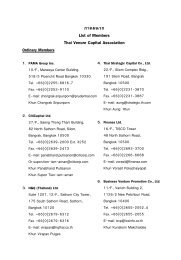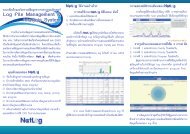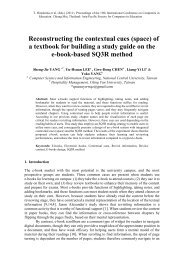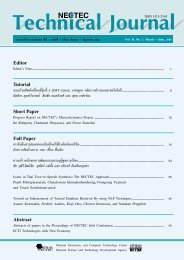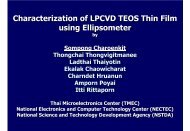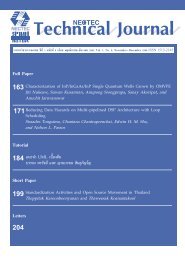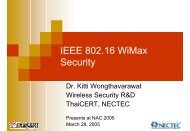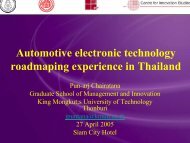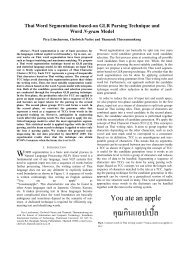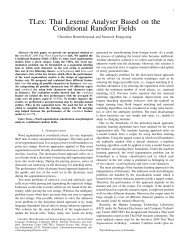ICCE 2009 Publications Format - Nectec
ICCE 2009 Publications Format - Nectec
ICCE 2009 Publications Format - Nectec
You also want an ePaper? Increase the reach of your titles
YUMPU automatically turns print PDFs into web optimized ePapers that Google loves.
T. Hirashima et al. (Eds.) (2011). Proceedings of the 19th International Conference on Computers in<br />
Education. Chiang Mai, Thailand: Asia-Pacific Society for Computers in Education<br />
Collaborative learning using LEBEL<br />
(Learning Ecology Based E-Learning)<br />
Toshiaki HONDA a* , Wakio OYANAGI b & Ryo TAKAOKA c<br />
a Faculty of Education, Ibaraki University, Japan<br />
b School of Professional Development in Education, Nara University of Education, Japan<br />
c Faculty of Education, Yamaguchi University, Japan<br />
*honda@mx.ibaraki.ac.jp<br />
Abstract: Learning ecology in learning is not limited to a specific type of learning, subject,<br />
or method. It is a concept that matches all types of learning. In this paper, we positioned the<br />
learning types in focus/navigation matrix proposed by Richardson as the basic learning<br />
types, and the learning ecology concept for each learning type was examined. We then<br />
attempted to create a learning environment based on the concept.<br />
Keywords: Learning ecology, e-Leaning, Focus/navigation matrix, learning environment<br />
Introduction<br />
In the learning ecology concept, learning indicates the learning that takes place in a new<br />
learning environment corresponding to social changes, and does not refer to specific<br />
learning contents or methods. Various efforts have been made in educational settings, and<br />
many of these are considered as learning ecology concepts. The learning ecology concept is<br />
a “paradigm concept that expresses learning as a whole,” with indexes such as<br />
collaboration, sustainability, community property, informality, etc. [1]. According to this<br />
concept, learning takes place in a learning environment that has implemented such<br />
ecological indexes. That is, the learning ecology concept is a “paradigm concept of learning<br />
itself” that is in harmony with social changes, sense of values in education, and changes in<br />
methods to acquire knowledge, and allows the realization of a sustainable and<br />
developmental circulation cycle of knowledge [2].<br />
1. Classification of learning type based on learning ecology concept<br />
Richardson uses two axes, one expressing the degree of focus on contents and experience<br />
and the other expressing instruction navigation from instructor-centered to learner-centered.<br />
The methods of learning are categorized into 4 quadrants separated by the two axes: i.e.,<br />
“Studying,” learning quadrant, “Projects” learning quadrant, “Teaching” learning quadrant,<br />
“Exercises” learning quadrant [3] [4].<br />
In the “Studying” quadrant, the learner tries to acquire necessary information from a variety<br />
of information sources, such as papers and the Web, and selects what is required from all of<br />
the collected information. Of course, the collected information may not be designed as<br />
educational content. In the “Projects” quadrant, learners engage in activities to solve<br />
problems found in actual life or in case studies. In the “Teaching” quadrant, the learners<br />
learn from the teacher in a lecture format that uses a blackboard, slides, and video clips. In
T. Hirashima et al. (Eds.) (2011). Proceedings of the 19th International Conference on Computers in<br />
Education. Chiang Mai, Thailand: Asia-Pacific Society for Computers in Education<br />
the “Exercises” quadrant, the learners engage in simple drills and practice questions with the<br />
teacher, or receive skill training to acquire skills necessary for problem solving from an<br />
instructor with expertise, such as instructors invited from a third party.<br />
2. Learning environment design using LEBEL and its effect<br />
2-1 Collaborative learning in the “Studying” quadrant<br />
2-1-1 Hypothesis in the “Studying” quadrant<br />
The “Studying” quadrant is a learning type in which the contents of learning are set, but the<br />
learner is responsible for deciding the learning activities. Inquiry-based learning used in<br />
Social studies and Science classes is this type of learning. In many cases using this type of<br />
learning, learning often takes place by individuals performing research, which is then<br />
discussed in a group, then a paper or report on the subject is prepared, and the information is<br />
shared within the class through group presentations. In this learning type, the teacher<br />
provides instructions on the contents of the activities, but plays a larger role as a supporter<br />
or advisor in the actual activities.<br />
2-1-2 Practice using a portal site (2010): Verification of the hypothesis<br />
(1) Practice environment<br />
Course unit name: Social Studies “People who work at a supermarket”<br />
Duration: October 12, 2010 to November 12, 2010<br />
Instructor: Instructor 1 Grade 3, Class 1 Homeroom teacher<br />
Instructor 2 Grade 3, Class 2 Homeroom teacher<br />
(2)Actual class<br />
In this learning, the portal site LEBEL was utilized to post necessary learning resources,<br />
and each student summarized their own research on a Wiki site. On the Wiki site, students<br />
read other students’ pages, and were asked to mutually link to each other’s sites to<br />
complement their own research content as well as to gain new insights. In addition, we felt<br />
that the participation of parents/guardians, who are the main purchasing customers for<br />
supermarkets, would be indispensable, and purposely planned for parents/guardians to take<br />
part in this learning.<br />
Figure 1 Information exchange (Class 2) Figure 2 Information exchange (Class 1)<br />
(3) Learning effect of using LEBEL<br />
In this practice, the learning effect was examined by focusing on how information of each<br />
individual (individual’s research content) was diffused and summarized. Figure 3 shows the
T. Hirashima et al. (Eds.) (2011). Proceedings of the 19th International Conference on Computers in<br />
Education. Chiang Mai, Thailand: Asia-Pacific Society for Computers in Education<br />
number of accesses to view other students’ pages (views), and the number of accesses to edit<br />
a student’s own summary page (edit). The figure indicates how students access other<br />
students’ pages to edit their own summary page.<br />
Figure 3.7 summarizes the relationships of mutual views based on the above information<br />
exchanges. Red lines indicate unidirectional views, blue lines indicate bidirectional views,<br />
and the thickness of lines indicates the number of views. The number of bidirectional views<br />
was 2267, and because indicating all the views would complicate the diagram, the views<br />
were counted when the same page was viewed by the same students more than 3 times. The<br />
figure indicates students that are the core (yellow) of information collection to create<br />
individual summary pages. The figure indicates how information from these core students<br />
complements each other and is diffused as new information.<br />
Figure 3 Mutual viewing<br />
In a normal classroom setting, the summaries for each student are exchanged as completed<br />
information. In such exchanges, the individuals can only evaluate each other, and are not<br />
able to create new knowledge or information. This case demonstrates a significant effect of<br />
learning that takes place under the LEBEL environment.<br />
References<br />
[1] Brown,J.S. (2000) ,Growing Up Digital: How the Web Changes Work, Education and the Ways People<br />
Learn.http://www.johnseelybrown.com/Growing_up_digital.pdf<br />
[2] Kimur, T. and Honda, T. Learning Effect of WBLE(Web Based Learning Ecology, )(JSET <strong>2009</strong>a)<br />
pp.873-874.<br />
[3] Richardson, A. (2002) , An Ecology of Learning and The Role of eLearning in The Learning<br />
Environment .http://citeseerx.ist.psu.edu/viewdoc/downloaddoi=10.1.1.120.1435&rep=rep1&type=pdf<br />
[4] Suzuki, K. Frame of clasify of classroom teaching aims,(NHK) (<strong>2009</strong>).<br />
http://www.gsis.kumamoto-u.ac.jp/ksuzuki/resume/books/1995rtv/rtv03.html#2



